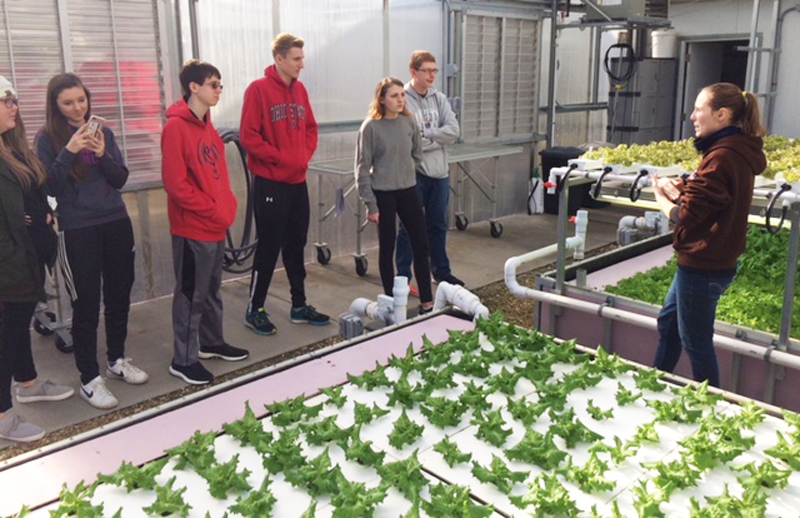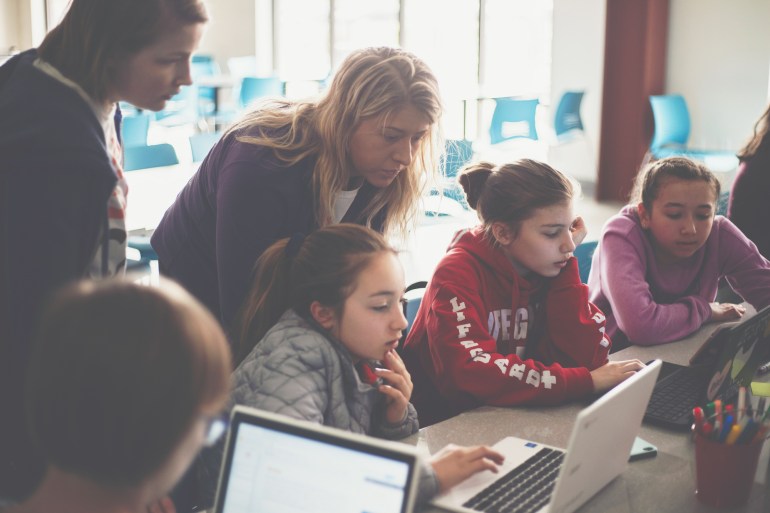How Do Art Programs in Schools Benefit Students for the Future?

iStock
The public education system in the US has been the same for over a century, with teachers talking at students and giving them tests. Simply at Iowa BIG, teens address their community's virtually pressing needs — and the results are benefiting them and their town.
In 2012, some members of the customs in Cedar Rapids, Iowa, asked, "What should schoolhouse wait similar?" To explore the question, they created the Billy Madison Project (yep, named subsequently the Adam Sandler moving-picture show in which a misbehaving adult goes back to schoolhouse), which brought 65 adults, including local leaders, to a high school to re-experience student life. All 65 of them went through an entire school 24-hour interval, complete with desks, lectures, textbooks, bells and permission slips to use the bath.
At the end of the day, they were asked, "What do yous think?"
Regardless of income, gender, age or politics, each participant reached the same determination: "We can practice much better."
They decided to create a program that made learning more meaningful — where students could cull how they use their fourth dimension and what they pursue, and where curriculum is integrated across disciplines and integrated with the customs. So, in the fall of 2013, they launched Iowa BIG. It started with but a dozen students; 207 are currently enrolled (and at that place'due south a waiting listing to go far).
This "school" has no building or curriculum. Its students attend their regular school part-fourth dimension, and commit several hours a twenty-four hours to Iowa Large, where they work with over 100 local organizations (businesses, nonprofits and policy groups) to identify issues they tin can assistance solve. The heart and soul of the school twenty-four hour period is the work these students do to improve their community.

Iowa BIG draws students from three Cedar Rapids school districts. These districts have historically viewed each other as rivals, but Iowa BIG has united them and the wider community; students, teachers and local organizations at present view themselves every bit a squad.
Assessment at Iowa Big is different and meaningful. The community partners come across often with students and their teacher, providing no-nonsense feedback. There's no ambiguity well-nigh their goals — the teens need to keep working until they solve the partner's problem, or fail.
"Students develop their work programme, organize information technology into tasks, and learn and do what's required to make progress. Individually or as teams, they piece of work on their own for long stretches," says Troy Miller, who cofounded Iowa BIG. "Faculty track progress and hold them accountable for completing work, non course omnipresence or checking off boxes."
The program doesn't work for every kid. To appointment, some fifteen per centum accept left and returned to normal school, but as Iowa BIG cofounder Shawn Connally says, even these kids cease up learning life lessons "an order of magnitude more important than turning in an essay on fourth dimension."
Of its roughly 500 graduates to date, some 97 pct who applied to college were admitted to their first selection. Since Iowa BIG students nonetheless participate in their normal schools, they're able to listing AP courses and extracurricular activities in their college applications.
"But Iowa BIG students also take a résumé worth looking at," points out Connally. 1 was waitlisted at the Air Strength Academy against long odds. In pleading his case, he emphasized his real-world experience with BIG, how he struggled with team dynamics, and what he learned well-nigh leadership. He got in. These distinctive experiences, as Connally puts it, "accept a lot more than value to many employers and colleges than a good Saturday score."
Many Iowa BIG students also go great summer jobs. "This twelvemonth, nosotros had a junior in high school who got a summer position at the University of Iowa Hospital, beating out 17 undergrads and 13 postgraduates. Without his Iowa BIG experience, he wouldn't have been able to get that internship," say the program's founders. "Nosotros tin't take credit for his intelligence, but we can take credit for giving him opportunities to be exposed to things that will take him to the side by side level."

"With the traditional model of education, learning is static — non much has changed in roughly 125 years. With this model, learning changes every day," they continued. "Plus, these kids get to know their community in new ways and appreciate it. That's really important. We have kids who used to call this place 'Cedar Crapids.' Now, one student away for higher told united states of america, 'I'd be a fool non to come back to my network.' "
Kyle came to Iowa Big to larn how to start a business organization. While at Large, he started a monster.com-like website, and though the site eventually failed, he won a competition with it and raised some money. In his second yr, he worked with a large local visitor, analyzing their distribution data using his coding and database skills.
"The VP asked him what he was planning to practise for the summer, and he said, 'Probably await tables.' The VP said, 'No, you're going to work for u.s.a..' He was hired as a full-fourth dimension data scientist writing code to analyze their business data," says Miller and Connally. "When he took a information science grade at his conventional high school, he failed. Now he is getting paid a healthy salary to do something that's an 'F' on his transcript."
As an Iowa Large freshman, Isaac designed underwater submersibles, helped his school system optimize practices for students who experienced severe childhood trauma, and designed and programmed drones — all in seven months. He says, "I also had a projection where I was researching genomes of different mushrooms and how to promote the commercialization of new species. A lot of my projects take been around making pocket-sized apps and websites. Through that, I've been introduced to several coding languages — TSS, THP, HTML, Arduino."
When he was 15, Isaac organized a summer class for middle-school kids, introducing them to the skills he learned through BIG: coding, Photoshop, making websites, building drones. He was paying it forrard to other kids, while making three times the minimum wage.
Connally adds, "As a instructor, I watch Isaac doing things he thinks of as coding projects. Students ofttimes don't explicitly see how other subjects are integrated into their learning. I call up most his ACES [childhood trauma] project: He's reading texts above grade level, contacting resources in the customs, interviewing adults, and understanding information. This psychology project is actually three or four classes … The buckets don't make full at the same rate, but overall they fill faster and deeper."
Miller shared a powerful explanation for how he concluded up at Iowa Large: "I left a well-off school commune for one that has all the archetype urban problems: poverty, economics, race relations. These are issues I care deeply about. Only subsequently years of telling these students that if they can just struggle through, then they volition get a job and get out of poverty, I realized: That's not true. These subjects and tests are not designed to cut the poverty bike," he says.
"As an teacher, I need to keep a pulse on what employers genuinely desire, and exist giving skills to students who don't have parents who can do that. Otherwise, I'm just prepping them for high school courses that will ready them for some intro college course that volition prepare them for more avant-garde college courses that basically prepare them for nothing. Meanwhile in higher, they are accumulating huge amounts of debt and will probably drop out, falling right back into the poverty trap."
Because Large is so different, some in the educational activity field view it cautiously. Miller says, "Some pushback comes from people who believe everything has to work on a set timeline, all English classes need to read certain books. In their value organization, they are correct, but that's non my value system and information technology's non the value system of business."
"Information technology'due south inexplainable to me that more parents don't advocate for their kids. It's fear — fear of modify, fear of what it will mean for college, and a lack of vision," he concludes. "I don't think it'due south going to come from within the schoolhouse. The community needs to step upward and say: Our students are non being prepared the way they need to be."
Your local school might non exist upwardly for something equally ambitious as Iowa BIG, only you can offset small with assist from Schoolhouse Retool (a nonprofit created past Stanford University'southward d.school), the Hewlett Foundation (funder of the Deeper Learning initiative), and blueprint business firm IDEO.
School Retool's mission is to assist schools create cultures of innovation. Their "Shadow a Student" campaign has enabled thousands of adults, unremarkably principals, to walk in a student's shoes for an unabridged twenty-four hours and then share reflections with their community. Drawing on these resource, y'all could invite community leaders to your school to shadow a student or a teacher. Like the civic leaders in Cedar Rapids, they could go your staunchest allies.
Excerpted from the new book What School Could Be: Insights and Inspiration from Teachers beyond America by Ted Dintersmith. Copyright © 2018 by Ted Dintersmith. Reprinted by permission of Princeton University Press.
Picket Ted Dintersmith's TEDxFargo talk hither:
Source: https://ideas.ted.com/how-can-schools-best-prepare-students-for-the-future-give-them-real-work-to-do/
0 Response to "How Do Art Programs in Schools Benefit Students for the Future?"
Post a Comment